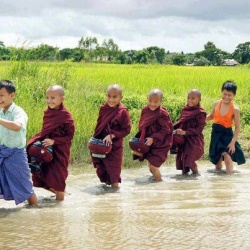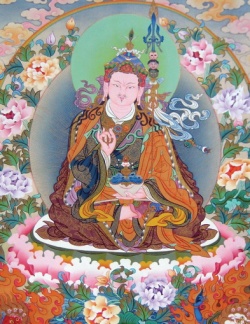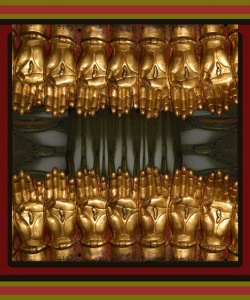Buddhism and Einstein (4) – Fallacy of Independent Time and Space
“Space does not have an independent existence.”
“Time has no independent existence apart from the order of events by which we measure it.”
Albert Einstein, Nobel Laureate in Physics
It has been about 100 years since both of Einstein’s Theories of Relativity were published. Since that time, they have had tremendous impacts not only on the scientific communities, but also on the general public as a whole. General Relativity greatly improved our understanding of the Cosmos and introduced terms such as “Black Hole” to the scientific community as well as the general public. Special Relativity, dealing with the structure of space-time, replaced Newtonian’s fixed-point reference frameworks with one where speeds of motions are relative to the motions of the observers. Time is no longer a constant and our aging process now depends on how fast we are travelling. As the quotes above indicated, Einstein dismissed the independent existences of time and space in no uncertain terms. Time and Space, despite our insistences to see them independently, have become one entity known simply as Spacetime. This post will discuss Space and Time and what Buddhism had to say about them that resonate so perfectly with what Einstein said.
Consciousness-Only School (Sanskrit = Yogacara, Chinese= 法相唯識宗) is a Mahayana Buddhist School which teaches that the manifestations of all phenomena (Sanskrit = dharma, Chinese = 法) in the external world exist only as a function of mental (Sanskrit – Citta) ideation. External objects are but projections of consciousness (Sanskrit = Vijnana, Chinese = 識) and have no natural basis of their own that correspond with their names. The mind, instead, designated the objects. It is the consciousness that reveals (as oppose to creates) to us the Universe that we know.
The discussion below represents a VERY simplified version of an INTRODUCTION to Consciousness-Only doctrine, often regarded as Buddhism’s version of psychoanalysis. It is a very important doctrine in Buddhism, very profound and not easy to understand. I present how it categorizes all the phenomena in the Universe here so I can put how Buddhism categorizes Time and Space into its proper perspective. It is not important that you understand intricacies behind the categorization completely. If you only understand what Buddhism deemed Time and Space to be and just how profound that was considering it was done 2500+ years ago without the help of advanced mathematics or precision scientific instruments, it will be sufficient for our current purpose. Even some scientists today have trouble comprehending the fallacies of independent existence of Time and Space.
According to a simplified summary of its categorization, all physical and mental phenomena can be grouped into five categories with a total of 100 items, as follows:
A) Mental Phenomena (Sanskrit = Citta-dharma, Chinese = 心法) – consisting of 8 consciousnesses.
Each one of us has six sensory organs, from which corresponding consciousnesses arise after information is received and filtered from the external environment. The six sensory organs and their respective consciousnesses are:
i) Eyes give rise to visual consciousness (Sanskrit = Caksurvijnana, Chinese =眼識);
ii) Ears give rise to auditory consciousness (Sanskrit = Srotravijnana, Chinese =耳識);
iii) Nose give rise to olfactory consciousness (Sanskrit = Ghranavijnana, Chinese =鼻識);
iv) Tongue gives rise to gustatory consciousness (Sanskrit = Jihvavjinana, Chinese =舌識);
v) Body gives rise to tactile consciousness (Sanskrit = Kayavijnana, Chinese =身識);
vi) 6th Consciousness, or Cognitive Consciousness (Sanskrit = Manovijnana; Chinese =意識). Unlike the previous five consciousnesses which are only capable of direct perception, mental consciousness is capable of thought, in addition to direct perception. Buddha said that it is here that cognition, or information processing, occurs.
Mental Phenomena refers to the fact the mind is present during any kinds of conscious activities. The mind receives and processes the information after going through the sensory organs and getting filtered.
This, of course, corresponds perfectly to today’s scientific teachings. Scientists tell us that all information comes to our sensory organs in nothing more than waves of different lengths, frequencies, amplitudes, degrees of entanglements etc. Since our sensory organs are incapable of receiving the full spectrum of the waves presented to them, our eyes, ears etc. essentially act as filters so that only a small portion of all the available information from the outside is received.
Then, this limited amount of information gets processed (examined, categorized, named etc.) in the mind. After processing, these waves become different colors, sounds, smells, tastes, sensations, shapes and textures etc. This mental differentiation (分别) of the information received results in the manifestation of different waves as myriads of physical and psychological phenomena (dharma). Thus a Universe specific to our senses is revealed (as opposed to created) to us.
vii) 7th Consciousness or Mana-Consciousness (Sanskrit = klistamanovijnana or afflicted mentality, Chinese = 末那識).
The 7th Consciousness has no essence of its own. Instead, using the differentiated information provided by the 6th consciousness, and mistakenly using a portion of the essence of the 8th Consciousness (below) as its independent self, the 7th Consciousness arises and develops different preferences to the differentiated information. It then clings to these preferences in various degrees of likes, dislikes or indifference. In this manner, self identify (ego) is constructed, together with the feeling of love (I crave), aversion (I hate), ignorance (nothing to do with me) etc.
The 7th Consciousness is called afflicted because the construction of a false Self (Sanskrit = Atman, Chinese = 我見) and its stubborn attachment (執着) to various carvings, aversions and ignorance leads broadly to the Three Poisons (Sanskrit = Trivisa, Chinese = 毒) of Greed, Anger and Benightedness.
Love, or craving, leads to Greed. Hatred, or aversion, leads to Anger. Ignorance leads to Benightedness. In Buddhism, These three poisons are considered broadly as the causes of all sufferings and vexations.
viii) The 8th Consciousness, or Alaya Consciousness (Sanskrit = Alayavijnana, Chinese = 阿赖耶識). It is also called Storage Consciousness, or Foundational Consciousness.
The 8th Consciousness is called Storage Consciousness because it is in here that seeds (Sanskrit = bija, Chinese = 種子) of consequences from past deeds (Sanskrit = karman, Chinese = 業) are stored. It is called Foundational Consciousness because, under the right conditions (Sanskrit = pratyana, Chinese = 缘), these seeds can fructify as experiences, which serve as support or foundation for future deeds. In this way, the 8th consciousness simultaneously produces consciousness and the objects of consciousness.
B) Conditioned Factors Concomitant with Mental Phenomena (Sanskrit = Cittasamprayuktasamskara , Chinese=心所有法) – consisting of 51 factors.
These 51 factors are associated with the mind in various combinations. They appear with the mind in conjunction and they are associated with the mind due to the five equalities that they share together – equality as to:
i) support (Sanskrit = Asraya, Chinese = 所依) – refer to the sensory bases;
ii) sensory objects (Sanskrit = Alambana, Chinese =所缘) – refer to sensory objects of cognition;
iii) aspect or image (Sanskrit = Akara, Chinese = 行相) – this refers to an image cast by an object, which then serves actual object of sensory perception;
iv) time (Sanskrit = Kala; Chinese = 時)- because they all happen at the same time;
v) the number of their substance (Sanskrit = Dravya, Chinese = 事實) –The mind and its concomitants are in a one-to-one association.
C) Form/Material Phenomena (Sanskirt = Rupa-dharma, Chinese = 色法): – consisting of 11 factors.
i) the 5 physical sensory faculties of the eyes, ear, nose, tongue and the body;
ii) the 5 materiality that serve as sensory objects of the 5 physical sensory faculties respectively mentioned above;
iii) materiality associated with mental factors (Sanskrit = dharmayatanarupa, Chinese = 法處所摄色) – including materiality generated in meditative states.
D) Unconditioned Phenomena (Sanskrit = asamskrta-dharma, Chinese = 無爲法) – consisting of 6 factors.
In Buddhism, all phenomena are either conditioned or unconditioned. According to Buddha: “all conditioned phenomena (Sanskrit = samskara) are impermanent (anityah sarvasamskarah)”. Conditioned phenomena, being impermanent, go through the following four stages from birth to extinction (Sanskrit = Samskrtalaksana; Chinese = 有爲相):
i) Birth/origination
ii) Duration/maturation
iii) Aging/Decay
iv) Extinction/Death
Unconditioned phenomena, contrary to conditioned phenomena, have no birth or death. They do not change and therefore are permanent.
Everything around us is impermanent, including our own earth, as it too will eventually be extinct. Impermanence of all phenomena is a truism in Buddhism, which we shall discuss in later posts.
Of the 6 Unconditioned Phenomena listed, only one is truly unconditioned and therefore permanent. The other five are only “seemingly unconditioned”.
The only truly unconditioned phenomenon is what Buddha called True Reality. Today, scientists have theorized its existence, but have not been able to find it, the reason for which was clearly predicted by Buddha. This is one of the most profound and abstruse topics in Buddhism. Therefore I will leave the more detailed discussion of it to future posts.
E) Conditioned Phenomena not Corresponding with Mentality (Sanskrit = Cittaviprayuktasamskara, Chinese = 心不相應行法) – consisting of 24 phenomena
These 24 phenomena do not correspond to Material Phenomena.
They are not permanent, and therefore do not correspond to the Unconditioned Phenomena.
While these 24 Conditioned Phenomena arise from mental faculty, they do not correspond to the Mental Phenomena as they do not have external constituents in the cognitive relationship between the subject (observer) and the object (observed), i. e. they do not have sensory bases as support, nor do they have sensory objects of cognition to be perceived. They are not based on concrete realities, specific objects, or actual instances. They are, therefore, nothing more than what we call “abstract concepts”.
It is in this category that Space and Time belong, occupying the 20th and 21st positions respectively. The word “Space”, as used here, refers to directional space (area, volume), and is not to be confused as Emptiness, which is one of the six Unconditioned Phenomena that is sometimes translated also as Space.
Buddhism, by categorizing Time and Space as abstract concepts, clearly understood that Time and Space has no independent existence, as Einstein did much later.
The categorization of Space and Time as abstract concepts and therefore do not have independent existences of their own has huge consequences as to what “reality” is. The explanation of that will come in the later post.
I will finish this post by letting Dr. Robert Lanza, mentioned above, explain what his perceptions are of Time and Space from a Biocentrism perspective. I think you will agree that calling Time and Space as “constructs” is pretty much the same as calling them “abstract concepts”, as Buddhism did 2500+ years ago!





